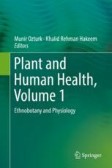Search
Search Results
-
Identification and functional characterization of squalene epoxidases and oxidosqualene cyclases from Tripterygium wilfordii
Key messageWe cloned two squalene epoxidases and five oxidosqualene cyclases, and identified their function using CRISPR/Cas9 tool and yeast...

-
Microbial Production of Terpenes
Sustainability is one of the main challenges facing humankind in the twenty-first century due to the continuous increase in the demand for energy and...
-
The Genus Terminalia (Combretaceae): An Ethnopharmacological, Phytochemical and Pharmacological Review
Terminalia Linn, a genus of mostly medium or large trees in the family Combretaceae with about 250 species in the world, is distributed mainly in...

-
Molecular Insight into Plant-Fungal Pathogen Interaction: Emerging Trends and Implication in Designing Climate-Smart Field Crops
Among the varieties of pathogens infecting plants, fungal pathogens are infamous for causing extensive damage to the plants. The establishment of...
-
An antioxidant activity of the whole body of Holothuria scabra
BackgroundHolothuria scabra is the potential source of terpene with high antioxidant capacity and one of the most valuable species in the trade.
...
-
Medicinal Plants Used for Musculoskeletal Disorders
In musculoskeletal problems, we come across more than 150 diagnoses affecting the locomotor system; muscles, bones, joints, and associated tissues...
-
Comparative analysis of phenolic compounds in four taxa of Erigeron acris s. l. (Asteraceae)
The aim of the present work was to investigate and compare the content of phenolic compounds in four taxa of Erigeron acris L. s. l.: E. acris (EAA), E...

-
Chemical composition, biological activities and traditional uses of plants from the segregated genus Caesalpinia sensu lato
The species Caesalpinia s.l. (Leguminosae: Caesalpinioideae) are widely distributed over all continents and content a large amount of unusual...

-
Maytenus ilicifolia Mart. ex Reissek
Herbal medicines are widely used in Brazil and currently constitute an expanding market. Among the species with the highest number of registration...
-
Ethnobotany and Pharmacological Uses of Elaeocarpus floribundus Blume (Elaeocarpaceae)
Elaeocarpus floribundus Blume belongs to the Elaeocarpaceae family which is widely distributed across warm regions like Madagascar, Mauritius, India,...
-
Mesopotamia-Paranaense Forest
The Mesopotamia, and particularly the Paranaense Forest, is briefly pictured regarding its geographical characteristics, weather, economical...
-
Cytotoxic effect of Semialarium mexicanum (Miers) Mennega root bark extracts and fractions against breast cancer cells
The root bark of Semialarium mexicanum (Miers) Mennega (cancerina) is traditionally used in Mexico to treat cancer. However, there are no studies...

-
A comparative bioefficacy of seed and root extracts of a medicinal plant, Withania somnifera when administered to prepupae of lepidopteran insects, Spodoptera litura (Lepidoptera: Noctuidae) and Pericallia ricini (Lepidoptera: Arctiidae)
BackgroundThe lepidopterans, Spodoptera litura and Pericallia ricini , are polyphagous pests of agricultural importance. The unscrupulous and...

-
Insights on the pharmacological, phytochemical and ethnobotanical aspects of Artemisia roxburghiana: a rather less explored but therapeutically important species of lower Himalayas
Artemisia roxburghiana Wall. ex Besser, belongs to the family Asteraceae (Compositae), is widely used in traditional medicine in Asia to treat...

-
Ethnomedicinal Investigation of Medicinal Plants of Chakrata Region (Uttarakhand) Used in the Traditional Medicine for Diabetes by Jaunsari Tribe
The Himalayan region is the treasure house of natural wealth, particularly of medicinal and aromatic plants. These plants are used by the Indian...

-
Genus Erythrophleum: Botanical description, traditional use, phytochemistry and pharmacology
Genus Erythrophleum belongs to family Fabaceae, which is commonly found in Asia, Africa, and Australia. Erythrophleum species have been employed as...

-
Lichens as a Potential Source of Bioactive Secondary Metabolites
Lichens are complex symbiotic associations between fungi and algae which are important constituents of many ecosystems. The production of various...
-
Phytochemistry and biological properties of Aristotelia chilensis a Chilean blackberry: a review
Aristotelia chilensis (Mol.) Stuntz, commonly called Maqui , is known for its pharmacological uses in traditional medicine of native Mapuche ...

-
Bioprospecting of plant natural products in Schleswig-Holstein (Germany) I: chemodiversity of the Cichorieae tribe (Asteraceae) in Schleswig-Holstein
Recent international developments make access to biological resources across international borders more difficult than in the past. Local access to...

-
Proteome profiling reveals insights into secondary metabolism in Maytenus ilicifolia (Celastraceae) cell cultures producing quinonemethide triterpenes
Plants produce a wide variety of secondary metabolites (SMs) of pharmacological interest that, due to their high structural complexity, are difficult...

